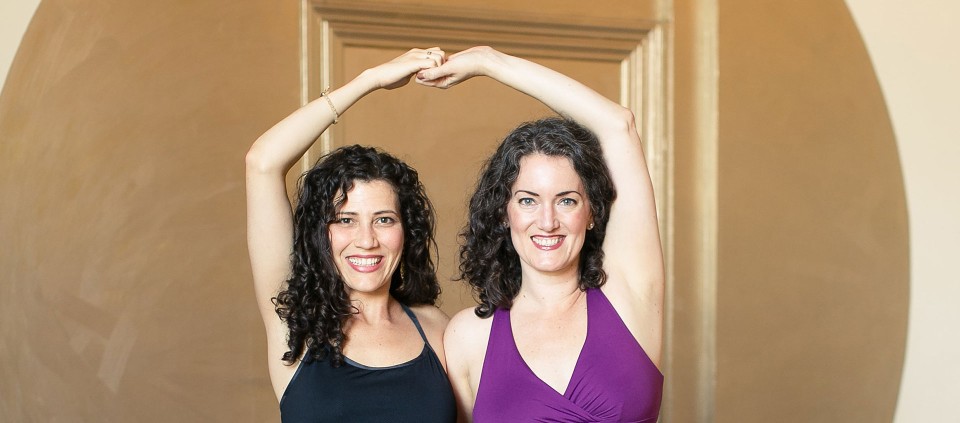Teaching Yoga Beyond the Poses: Confidence and Authenticity

by Sage Rountree and Alexandra DeSiato
When you feel nervous, insecure, afraid, or timid, it’s hard to be authentic. Nervous energy and anxiety are often read as inauthenticity, in part because they seem to transmit the idea that something is wrong. That’s a frustrating reality for those of us who by design of genetics tend toward anxiety! The good news is that yoga gives us some tools for that, especially breath. The other good news is that most of this nervous energy and anxiety can be mitigated by thorough preparation.
Preparation begets confidence. When you’ve calmly planned your class sequence, including ways to expand or contract it for time; when you’ve lined up your music and collated your quotes; when you’ve set out the props each student will need and taken a moment to greet each student as they arrive—then you’ll start class feeling confident. And if things go wrong, as they sometimes do, you’ll have a plan to get back on track. Thinking through the potential pitfalls will help boost your confidence.
Thoughtful planning begets confidence, and your confidence makes students feel safe. If you seem to know what you’re doing (even when you may not feel like you know what you’re doing!), then your students feel that they are safe to trust you to lead them through movement and philosophy. This is important: When students feel safe, they let go more, and they get more out of the practice. Consider your most-loved teachers: Don’t you trust them? And doesn’t this trust translate for you into a deeper experience of movement and relaxation?
Authenticity-from-confidence can also be something that develops over time, as you get a little more comfortable with your class and your students. When they come back time and again, revealing that they like and trust you, we bet you’ll find it easier to be yourself more fully with them.
Do People Want You to Be Genuine? Yes—and No
Let’s start with the obvious: People want you to be genuinely you. They want to see your brand of humor, your compassion, and your values. When students return to your class, they do so because they’ve found something about you likeable, enjoyable, and sincere. They’re there for yoga, but specifically your take on yoga. Cultivating honesty and authenticity will help you find students who will most love your classes. Being your true self will help you connect to your true students.
Sometimes, though, your genuine self is angry or heartbroken or broke. Sometimes your genuine self is feeling really down. This is where the words “genuine” and “authentic” can be confusing in the context of another important word: professional. You are a professional teacher, and your job is teaching yoga. (That’s the case whether it’s a full-time job, part-time job, or hobby; when you agree to lead a class, professionalism comes with that responsibility.) Ostensibly, the students who attend your class are paying you to lead them. Generally, that payment is in money, but it may also be a trade for services or it may even be a free class, in which case students are paying with their time and attention.
If someone is paying you in any way to lead them through an inspiring yoga practice, there is definitely room for your authentic self. But you have to be sure that your authentic self doesn’t detract from the experience you’re trying to create.
Here’s what we mean. Imagine you show up for a massage ready to be quiet and let your stresses melt away and in need of deep tissue work for tight quads. You go to a massage therapist you really like and that you’ve been to before, but when you arrive, he is obviously distracted and seems sad. You ask, politely, if everything is okay, and he tells you he’s going through a significant breakup. Because he seems in need of care, and because you truly like this person, you ask questions and the two of you talk about his heartbreak through the massage. Because you are empathetic, you don’t remind him that your quads are really tight when he seems to have forgotten the deep-tissue work you need—he is distracted for a good reason. His heart is broken! At the end of the massage, he thanks you for being so supportive and kind. And you leave feeling kind for listening to him, but having given a lot of money and a lot of time for a service that didn’t quite meet what you needed. Would you go back? Would you feel a little bummed out to have spent your money and time on a massage that wasn’t great and that actually required you to expend energy?
As a teacher, don’t take up so much space that your students can’t relax or release or let go. Don’t share so much of your sadness or frustration or your troubles that your students feel the need to support you or lift you up. Don’t ask your students to give to you emotionally when part of your job as a professional yoga teacher is to give time and energy to your students. It is not an equal exchange of energy. Your students are not your friends. There are certainly ways to teach well when you’re in that empty-well place. But we don’t think taking energy from your students is very professional, even if it is genuine sometimes. So if you feel like you have to choose between the two things, genuine emotion or professionalism, choose the latter. Or get a sub.
Find out about programs with Sage Rountree at Kripalu.
From Teaching Yoga Beyond the Poses by Sage Rountree and Alexandra DeSiato, published by North Atlantic Books, copyright © 2019 by Sage Rountree and Alexandra DeSiato. Reprinted by permission of publisher.